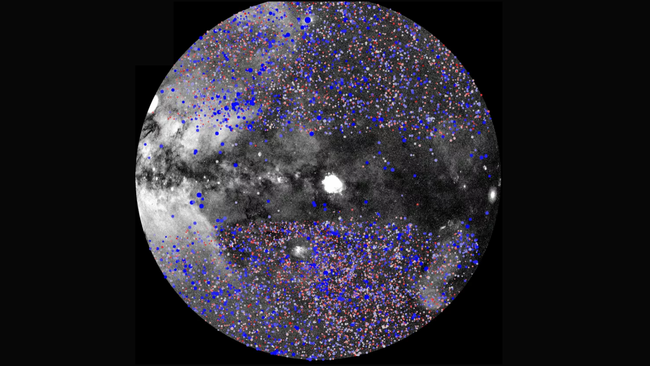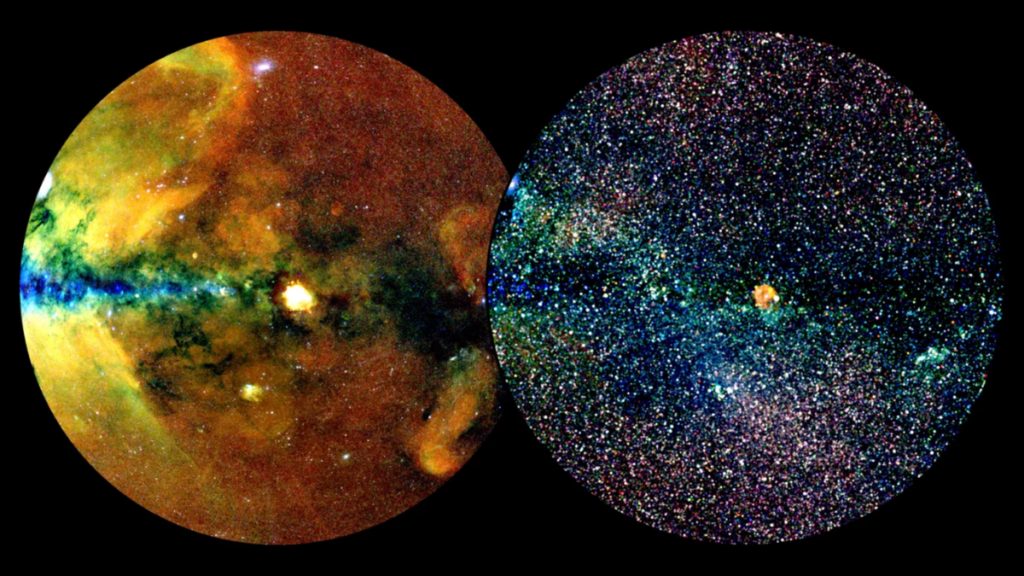A significant X-ray sky survey has the potential to alleviate the crisis related to the universe’s uneven distribution of matter.
Perhaps the cosmologists can now take a moment to unwind.
A recent analysis examining the evolution of galaxy clusters throughout the 13.8-billion-year history of the cosmos has the potential to address a longstanding discrepancy regarding the uneven distribution of matter in our universe. Furthermore, this analysis may provide insights into various other enigmatic phenomena in the cosmos.

The initial data obtained from the eROSITA all-sky survey of cosmic X-ray sources, which concluded 4.5 comprehensive surveys of the entire sky in February 2022, yielded precise measurements pertaining to the total quantity of matter in the universe and the uniformity, or “homogeneity,” of this matter.
These findings have the potential to reconcile the disparity between the theoretical predictions of the standard model of cosmology and the observations of the cosmic microwave background (CMB), a cosmic relic originating shortly after the Big Bang. Currently, these two sources of information diverge in their assessment of the lumpiness of matter in the universe.
The S8 tension, which refers to the difference in the amplitude of matter fluctuations on a large scale, has become widely recognized. Scientists use the parameter S8 to quantify this disparity, specifically on the scale of approximately 26 million light-years. Essentially, it describes the unevenness or “lumpiness” of the cosmos.
While the S8 tension may not be as significant of an issue in cosmology as the “Hubble Tension,” which pertains to the disagreement in calculations of the universe’s expansion rate, it still poses a growing concern. Some have even suggested that we may need to explore entirely new physics in order to resolve this perplexing situation. However, there is hope that the new eROSITA data can alleviate the S8 tension without resorting to such drastic measures.
According to Esra Bulbul, the lead scientist for eROSITA’s clusters and cosmology team, the recent findings from eROSITA have established cluster evolution measurement as a valuable tool for precision cosmology. Bulbul stated, “The cosmological parameters that we derive from galaxy clusters align with the latest cosmic microwave background (CMB) data, indicating that the same cosmological model remains valid from the early stages of the universe to the present day.”
Solving a brewing cosmic crisis with eROSITA
The standard model of cosmology, also known as the “Lambda Cold Dark Matter (ΛCDM) model,” proposes that the universe was initially a dense and hot sea of photons, free electrons, and protons right after the Big Bang.
At that time, electrons were thought to have continuously scattered photons, making the universe essentially opaque. However, approximately 400,000 years later, as the universe expanded and cooled, electrons and protons came close enough to bond and form the first hydrogen atoms.
During the reionization period, photons were able to travel freely, making the universe transparent to light. This “first light,” known as the Cosmic Microwave Background (CMB) or the “surface of last scattering,” now fills the universe almost uniformly and serves as a valuable tool for understanding the evolution of the cosmos.
Over time, the first atoms grouped together to create gas clouds, then stars, which eventually formed galaxies that clustered into galactic clusters, leading to some of the largest structures in the universe.
Observations of these clusters by eROSITA, the main instrument on the Russian-German Spectrum-Roentgen-Gamma (SRG) spacecraft, indicate that visible matter and dark matter make up 29% of the total energy density of the universe, consistent with CMB measurements.

In the statement, Vittorio Ghirardini, research leader and postdoctoral researcher at the Max Planck Institute for Extraterrestrial Physics, mentioned that eROSITA’s observations indicate that the universe followed the expected behavior over cosmic history. He also noted that there is no discrepancy with the CMB findings, suggesting that cosmologists can now possibly ease their concerns.
Cosmic ghost hunting
eROSITA’s study of galactic clusters has also contributed to scientists’ understanding of neutrinos, which are extremely small particles with minimal mass and charge, making them nearly undetectable. In fact, an astonishing 100 trillion neutrinos pass through our bodies every second without us even noticing. This elusive nature has earned them the nickname “ghost particles.”
The minuscule mass of these particles allows them to traverse the cosmos at speeds approaching that of light, leading astronomers to describe them as “hot.” Temperature is essentially a measure of particle velocity, and neutrinos’ high speeds enable them to evenly distribute matter throughout the universe. This phenomenon can be studied by examining the evolution of the largest cosmic structures we are aware of.
By combining eROSITA’s observations of galactic clusters with data from the CMB (Cosmic Microwave Background), scientists have achieved the most precise measurements to date of the total mass of neutrinos using cosmological methods.
“It may seem contradictory, but we have obtained precise constraints on the mass of the lightest known particles by studying the abundance of the largest dark matter haloes in the universe,” stated Ghirardini. “We are even on the verge of a breakthrough in measuring the total mass of neutrinos when we combine our findings with ground-based neutrino experiments.”
eROSITA’s exploration of the universe extends beyond its initial findings. In addition to its other contributions, the data collected by this instrument has the potential to unveil the growth rate of the universe’s largest structures, a phenomenon foreseen by Einstein’s General Theory of Relativity in 1915.
A preliminary examination of 12,247 clusters of galaxies identified through optical means by eROSITA suggests that this growth rate may be slightly slower during later cosmological periods than what is predicted by general relativity.
Emmanuel Artis, a postdoctoral researcher at the Max Planck Institute for Extraterrestrial Physics, expressed his anticipation for a potential breakthrough, stating, “We may be on the verge of a significant discovery. If confirmed, eROSITA will open up new avenues for captivating theories that go beyond the realm of general relativity.”
Do not forget to share your opinion with us to provide you with the best posts !



0 Comments